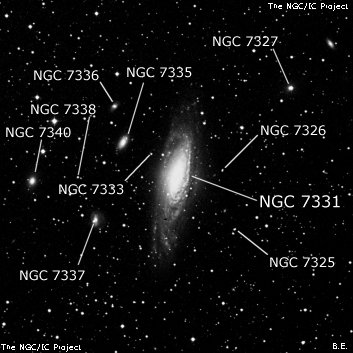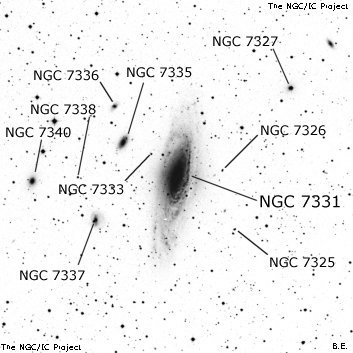NGC/IC Project Restoration Effort
(This is a very very beta version)
NGC7331


Basic Information
Location and Magnitude
Right Ascension: 22:37:5.1
Declination: +34:25:13
Constellation: PEG
Visual Magnitude: 9.5
Historic Information
Discoverer: Herschel W.
Year of discovery: 1784
Discovery aperture: 18.7
Observational
Summary description: B, pL, pmE 163°, smbM
Sub-type: Sbc
Corwin's Notes
=====
NGC 7331. See NGC 7320, NGC 7325-27, and NGC 7335.
Steve's Notes
=====
NGC 7331
48" (10/24/14): at 488x, the long dust lane along the west side (running N-S) was prominent as the galaxy is sharply cut off at the bright edge of an inner spiral arm. A clearly visible outer spiral arm curves sharply counterclockwise around the south side of the halo and shoots directly north. It continues or merges into a fairly narrow arm just west of the dust lane and extends beyond the central region on the west side.
24" (7/21/12): at 322x this showpiece galaxy appeared very bright, very elongated 3:1 NNW-SSE, ~9'x3'. Contains a very bright, elongated core that is sharply concentrated with an intense stellar nucleus. The galaxy exhibits subtle spiral structure in the outer halo and the brighter edge of the inner western arm is sharply defined as it shoots north. Just west of this arm the light drops off sharply due to a long dust lane and the dim glow of the outer halo is clearly visible west of the lane. Arm structure is also evident at the north and south ends of the central region. The four background companions to the east fit snugly in the field.
18" (8/1/08): The sharp light cut-off (dust lane) was evident, running along the west side of the galaxy, and the outer halo had subtle structure and variations in brightness that suggested spiral structure.
13.1" (7/27/84): very bright, very elongated 3:1 NNW-SSE, 9'x2.5', very bright elongated core, substellar nucleus. The west side has a sharper edge due to dust. Four companions are close following with the brightest three NGC 7335 3.5' ENE, NGC 7337 5.2' SE, NGC 7336 5.3' NE and NGC 7340 8.1' E of center. Stephan's Quintet lies 30' SSW.
8" (8/28/81): very bright, large, nucleus bulge, very elongated. Two extremely faint companions to the east are just visible.



